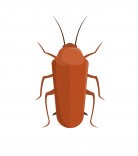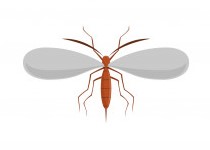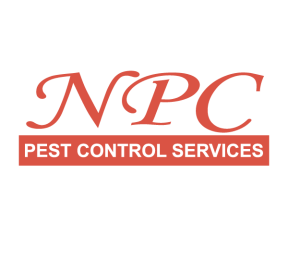
Termites
Subterranean Termites
Family Rhinotermitidae
Subterranean termites live in underground colonies or in moist, secluded areas above ground that can contain up to two million members.
The appearance of subterranean termites depends on their caste within the colony. Worker termites are cream-colored and 1/8 to 3/8 inches long, while the soldier termites have powerful mandibles, brown heads, and cream-colored bodies, as pictured below. Rounding out the caste system are larger, reproductive termites that look like winged ants and are approximately an inch long. Reproductive subterranean termites can often be distinguished from drywood termites by the single, dark vein that runs through their wings.
Subterranean Termite Tubes & Habitat
Subterranean termites need contact with the soil to survive and thrive underground, which is why they build their distinctive "mud tubes" (sometimes called “termite tubes”) to gain access to food sources and to protect their colonies from the open air. These industrious termites can even build tunnels through cracks in the concrete.
Potential Threats
Causing over RM8.23 billion in damages every year, subterranean termites are by far the most destructive species of termite. Capable of collapsing entire buildings, subterranean termites can mean financial ruin for homeowners and businesses. The hard, saw-toothed jaws of these termites work like shears to bite off small fragments of wood, one piece at a time.

Cockroaches
American Cockroaches
Periplaneta americana (L.)
The American cockroach is the largest of all house-infesting cockroaches. Contrary to its name, the American cockroach was introduced to the United States from Africa as early as 1625.
American Cockroaches
Color Reddish brown, with a yellowish figure 8 pattern on the back of the head
Legs 6
Shape Oval
Size 2"
Antennae True
American Cockroach Habitats
American cockroaches are most commonly found in homes and food-processing and storage areas. They are active when the temperature is 70 degrees or higher, but they can survive in lower temperatures under the right conditions.
With three life stage cycles — egg, nymph, and adult — immature cockroaches require six to 12 months to mature. Nymphs go through up to 13 moltings before reaching maturity. Often living another full year, the average female cockroach produces 150 young during her lifetime.
The American Cockroach Habitat
American cockroaches are often found in sewers and basements, particularly around pipes and drains. They prefer moist, warm areas above 84 degrees and thrive in crawl spaces, sewers and summer weather.
Human activity has greatly expanded the range of American cockroaches, which now thrive in tropical climates with frost-free winters.
Cockroaches love to munch on cheese, beer, leather, baked goods, book bindings, glue, hair, dried skin flakes, decaying organic matter, dead animals, soiled clothing, fermented foods and even other roaches.
Identifying an American Cockroach
Measuring up to two inches in length, adult American cockroaches are reddish-brown or mahogany colored, while immature cockroaches resemble adults, but are wingless and gray-brown in color. Though American cockroaches have wings, they rarely fly unless temperatures exceed 85 degrees.
Capable of squeezing into small spaces, American cockroaches are one of the fastest running insects, with record speeds of 3.4 miles per hour, which would be comparable to a human running 210mph.
Do American Cockroaches Bite?
Voracious omnivores, cockroaches are known to feed on plants and meat. Though they have been known to eat dead and living human flesh, they are most likely to chew on fingernails, eyelashes, feet, and hands. Such attacks can cause irritation, lesions, swelling and even minor infection.
Preferring exposed or discarded food to human flesh, roaches are most likely to attack humans during large infestations where food sources are limited.
Signs of an American Cockroach Infestation
During the winter, these little buggers come inside, seeking warmth and readily available food. They often enter homes through sewer connections, under doors, around plumbing, and through air ducts.
Preferring to live and feed under the cover of darkness, cockroaches spotted during the day could signal a serious infestation. Their penchant for dark, moist places means cockroaches can be found behind fridges, under sinks and stoves, inside floor drains, beneath rubber mats and within wall cracks. Outside, you may spot American roaches wandering through mulch, woodpiles, flowerbeds and under shingles.
Cockroach feces resemble coffee grounds or black pepper, while larger roaches produce cylindrical droppings. If the infestation is large enough, a strong, oily or musty odor may be present. Oval-shaped egg casings can sometimes be found behind furniture or between books.

Mosquitoes
Mosquitoes
Culex species and others
One of the best known summer pests, mosquitoes breed in stagnant water or soft soil and can develop from egg to adult in 10 to 14 days.
Mosquitoes
Color Varies; Pale brown with whitish stripes across abdomen
Legs 6
Shape Narrow Oval
Size 1/4" - 3/8"
Antennae True
Habits
Female mosquitoes suck our blood. Male mosquitoes feed on plant nectars. They can develop from egg to adult in 10 to 14 days. They are most active from dusk to dawn and will fly up to 14 miles for a blood meal.
Habitat
Mosquitoes breed in stagnant water sources such as storm drains, old tires, children's wading pools and birdbaths.
Threats
Mosquitoes are well-known to spread diseases such as West Nile Virus, malaria and dengue fever.
Prevention
Eliminate or reduce mosquito breeding sites by replacing all standing water at least once a week. This includes bird baths, ponds and unfiltered pools. Remove unneeded vegetation or trash from around any standing water sources that cannot be changed, dumped or removed. Introduce mosquito-eating fish such as gambusia, green sunfish, bluegills and minnows to standing water. Screen windows, doors and other openings with mesh. Avoid going outdoors when and where mosquitoes are most active: during dusk or dawn. Use insect repellent containing picaridin on exposed skin, according to label directions.

Ticks
Brown Dog Ticks
Rhipicephalus sanguineus
This is one of the most widely distributed ticks in the world, and there are records of its occurrence on a number of hosts. By far the most common host is the domestic dog, and the brown dog tick is virtually restricted to this host.
Brown Dog Ticks
Color Uniformly red-brown with tiny pits scattered on the back
Legs 8
Shape Flat
Size 1/8" long
Antennae False
Habits
Under normal circumstances in North America, all feeding stages of the tick feed on dogs. The adults commonly attach to the ears and between the toes, and the larvae and nymphs are often found in hair along the back. When the individuals of each feeding stage become fully engorged, they drop from the host and seek some protected situation in the immediate surroundings. For this reason, all tick life stages may be found behind baseboards, around window and door moldings or in furniture.
Habitat
Brown dog ticks can be found outdoors in the southern United States during any time of the year, but they are found active outdoors only during the warm months in the northern United States. The female may deposit as many as 5,000 eggs in places such as between boards, under plaster or carpeting or in other cracks and crevices.
Threats
A home can become heavily infested if the family dog picks up ticks from an infested residence, boarding kennel, open field, or similar place where other infested dogs have been present.
Prevention
Some non-product techniques that help reduce tick problems include keeping grass and weeds cut short in tick-infested areas. Sealing cracks and crevices where ticks can hide, both inside and on the exterior of the home, will aid in management. Checking the dog prior to entering the home and removing any ticks found will also help reduce the chance for ticks to infest the home. The dog must be treated if the infestation is to be eliminated, and the treatment should be performed by professionals trained in animal treatments such as veterinarians.

Rats
Roof Rats
Rattus rattus
Originating in Southeast Asia, roof rats get their name from their love of climbing and living in high buildings. Ranging from six to eight inches in length, not including their tails, roof rats are colorblind and have very poor vision. They do, however, have extremely strong senses of hearing, smell, touch, and taste.
Roof Rats
Color :Black
Legs : 4
Shape : Long
Size : 16" total (6-8" body plus 6-8" tail)
Antennae False
What Do Roof Rats Do?
Smaller in size and with longer tails than Norway rats, roof rats are well adapted for climbing vines, wires and narrow ledges. Skittish, smooth-furred and not well adapted to cooler temperatures, roof rats are often mistaken for house mice.
Though they may be cute, these critters can cause major damage by chewing on housing materials and eating stored foods. In late fall, roof rats seek out warm nesting sites like the upper levels of your home or garage. Becoming sexually mature in a matter of months, roof rats typically have five to eight pups per litter and four to six litters per year.
Though they will eat meat and grain, these adorable beasties love to feed on fresh fruit, plant materials, nuts, seeds, vegetables, tree bark and even bird feed.
Are Roof Rats Dangerous?
Notoriously hard to eradicate, roof rats secured their place in history by spreading the bubonic plague that decimated Europe in the Middle Ages.
Still to this day they pose some threats to humans. Besides being carriers of ectoparasites, these cute little purveyors of mayhem also love chewing on wires in your home or car and will gnaw on nearly anything to keep their incisors from growing.
They can cause structural damage by undermining the foundations of buildings, roads, and walkways, and have been known to chew through plastic and lead pipes, doorframes, upholstery and electrical wires.
Signs of a Roof Rat Infestation
Look for signs of hollowed-out fruits, capsule-shaped droppings about ¼ to ½-inch in length, gnaw marks on your home or trees, grease and urine stains, live or dead rats or rodent odors.
Check insulation for nesting sites, inspect exposed wiring for gnaw marks and listen for the sounds of rats running or digging inside walls, attics, garages or chimneys. They may be cute, but these tenacious critters can chew through wood, plastic, aluminum siding, sheetrock and even soft metals.

Flies
House Flies
Musca domestica
House flies earned their name by being the most common household fly. With hairy black bodies, translucent wings and big brown eyes, house flies can be found across the globe. They are incredibly fast and agile, and their large eyes allow them to see nearly everything around them. These pests generally live between 15 and 25 days.
House Flies
Color Dark gray
Legs 6
Shape Small Oval
Size 1/4"
Antennae False
House Fly Habits
House flies are highly attracted to manure, so they are often found around farms. These pests generally stay within a mile or two of their birthplace, but they have been known to travel up to 20 miles in search of food. House flies enjoy being in the sun, and will perch in sunny spots around your home — retreating to rest at night.
What Do House Flies Eat?
House flies are only able to ingest liquids, but they can turn solids into liquids by spitting on it. They especially enjoy sweet and fermenting fruits. And interestingly enough, house flies’ tastebuds are located on their hair and feet. These sensors are 10 million times more sensitive to sugar than the human tongue.
How Long Can a House Fly Go Without Food or Water?
House flies can survive without food or water for two to three days.
House Fly Threats
House flies do not sting or bite, but they can be a substantial threat to humans. These pests carry up to 100 different disease-causing germs and can be incredibly harmful to your health, so it’s important to make sure these flies stay away from your home.
Signs You Have a House Fly Infestation
The most common sign of a house fly infestation is finding these pests flying around your home, particularly in locations where food is found. If you suspect you may have an infestation, investigate your food sources for potential eggs or larvae.
How To Prevent an Infestation
The best way to prevent an infestation is to keep adult flies from entering your home. Place mesh screens on all of your windows and doors, and be sure to diligently clean your home, especially areas where food is frequently prepared or consumed. Additionally, hanging a plastic bag of water from your doorframe will discourage house flies from entering your home, as the presence and movement will mess with their vision and deter them from coming inside.

Bed Bugs
Bed Bugs
Cimex lectularius
Bed bugs get their name because they like to live and feed in beds.
Bed Bugs
Color Mahogany to rusty brown; red after a blood meal
Legs 6
Shape Flat; Broad oval
Size 1/4"
Antennae True
Habits
Bed bugs like to travel and will hide in suitcases, boxes and shoes to be near a food supply. They are elusive, nocturnal creatures. They can hide behind baseboards, electrical switch plates, picture frames, even wall paper. They come out at night for a blood meal.
Habitat
Bed Bugs like to hide in small cracks and crevices close to a human environment. They can be found behind baseboards, wallpaper, upholstery and in furniture crevices.
Threats
Although bed bugs can dine on any warm-blooded animal, they primarily dine on humans. Bed bugs do not transmit diseases, but their bites can become red, itchy welts.
Prevention
Vacuum suitcases after returning from a vacation. Check your bedsheets for tell-tale blood spots. Consider bringing a large plastic trashbag to keep your suitcase in during hotel stays. Carry a small flashlight to assist you with quick visual inspections. Bed bugs are elusive creatures, so it is imperative to seek professional pest control to address an infestation.

Ants
Odorous House Ants
Tapinoma sessile
This ant gets its name from the strong, rotten coconut-like smell it gives off when crushed. These tiny insects range in size from one-sixteenth of an inch to one-eighth of an inch long, and they can live for many years.
Odorous House Ants
Color : Brown or black
Legs : 6
Shape : Segmented; oval
Size : 1/16-1/8
Antennae : True
Odorous House Ant Habits
Odorous house ants like to construct their nests in wall voids, especially around hot water pipes, heaters, crevices and sinks. Outside they prefer to nest in exposed soil. These ants enjoy sweet things, and mostly go inside when their honeydew supply is reduced due to heavy rain.
Do Odorous House Ants Bite?
Odorous house ants do not bite. The only threat they pose to humans is their love for foods — thus posing a contamination risk.
Do Ants Have an Odor?
When these ants are crushed they emit a foul, rotting coconut odor.
Signs You Have an Odorous House Ant Infestation
The most likely way to spot an infestation is to see the ants walking around. In summer months, odorous house ants swarm and winged ants will appear around the nest. If you see these swarmers, there is most certainly an infestation.
QUICK SERVICE ON OUR HOTLINE CALL - MON-SAT 9AM-6PM
“We care for your well-being and property”


